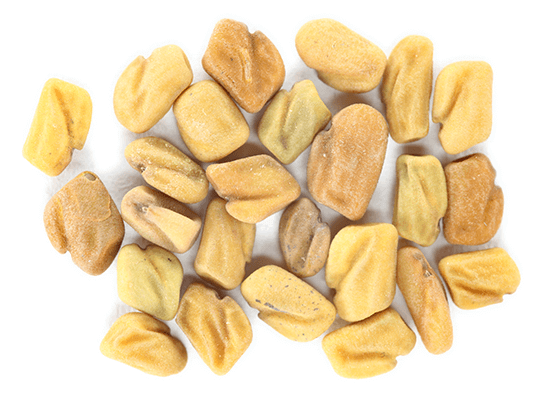Fenugreek – a versatile plant in animal feed (part 1)
Fenugreek is one of the oldest cultivated and medicinal plants in the world. Thousands of years ago, the herbaceous plant was already highly regarded in the cultures of Egypt, China, India, the Arab countries, the Roman Empire and Greece. Learn in this first part of our series about the history of fenugreek.
Spotlight on Fenugreek - a powerful phytogenic
You’ve never heard of fenugreek? Don’t worry, compared to other herbs like thyme, rosemary or basil, fenugreek is relatively unknown in Europe. Herewith we want to show the benefits of fenugreek for humans and animals.
What to discover in this series?

Looking back on the long history of fenugreek....
…it has been used for several reasons. Fenugreek was used in ancient Egypt, where it played a role in both herbal medicine and religious acts. In Greece and other countries, fenugreek is still used as animal feed. This is where the Latin name of fenugreek Trigonella Foenum-Graecum comes from, which means „Greek hay“.
Fenugreek is one of the oldest cultivated and medicinal plants in the world. Thousands of years ago, the herbaceous plant was already highly regarded in the cultures of Egypt, China, India, the Arab countries, the Roman Empire and Greece. Fenugreek was probably even one of the first plants ever cultivated by man: the oldest seed findings date back to the 6th millennium B.C. near the Euphrates and Tigris rivers. A clay tablet from the 8th century B.C. documents fenugreek as a plant of the royal medicinal plant garden of the Babylonian King Marduk-apla-iddina II.

The first written mention of fenugreek, however, dates back some 900 years earlier: scrolls from ancient Egypt recommended the use of fenugreek for the treatment of burns. The Greek physician Hippocrates (ca. 460-370 B.C.) also recommended the use of the plant – but for tumours. Fenugreek finally made its way north of the Alps through Benedictine monks, who cultivated it in their monastery gardens. In addition, Charlemagne’s Capitulare de villis, which was issued in 795, decreed that fenugreek be cultivated in the king’s gardens, monastery gardens and crown estates.

Nowadays the use of fenugreek is widespread, especially in India. It is an indispensable ingredient of curry. Usually, fenugreek has no harmful effects on health, though sometimes it can cause allergic reactions in people who are sensitive to peanuts.
Fenugreek is mainly used as leaves (fresh or dried), as seeds (whole or ground) or as extract. The form depends on the type of use, from spices, vegetables, tea, through cosmetic products to animal feed – the range of applications is wide. Did you know that fenugreek is mainly used in nursing teas because it stimulates the production of milk? In addition, some people also take fenugreek capsules as a dietary supplement because of their high content of vitamins and minerals.

Fenugreek in Portrait
Fenugreek (Trigonella foenum-graecum L.) belongs to the Fabacea family, also known as butterfly blossom plants or legumes. Like over 70 other species, fenugreek belongs to the genus Trigonella. The annual herbaceous plant with light green leaves and small flowers grows to about 60 cm high and forms a deep reaching tap root.
Fenugreek can be found in dry biotopes of the eastern Mediterranean region and West Asian countries. The plant prefers nutrient-rich, warm and sunny locations and is therefore cultivated today mainly in India, Turkey, Morocco and France. Until a few years ago, fenugreek was also cultivated in Lower Austria for the feed and pharmaceutical industries. However, in modern agriculture the plant is considered to have too low yields. In arid regions, however, it is worthwhile cultivating the plant: where heavy irrigation has led to soil salinisation, optimal conditions are available for salt-tolerant fenugreek.

From June to July fenugreek blooms with pale yellow flowers. The flowers, which are fertilised by bees, bumblebees or butterflies, develop into legumes up to 15 cm long and 1 cm wide. The pods contain up to 20 yellowish reddish-brown rhomboid seeds of about 3-5 mm long and 1-2 mm thick, which are divided into two unequal halves by a diagonal furrow.
Fenugreek is characterised by its peculiar, sweetishly spicy smell. This coumarin-like smell even intensifies with drying. When the seeds germinate, the smell is more reminiscent of celery – the seedlings also taste bitter and are slimy when chewed.
Do you want the entire article as PDF including all references?

You are only one click away.
How would you describe the smell of fenugreek?

Anne Oberdorf
Anne has always been fascinated by the unknown, the diversity and beauty of nature. Her love for nature brought her to Delacon in 2018 after studying agricultural sciences, where she worked as Technical Communications Manager and later as Product Manager Aquaculture. Since February 2021, she has been taking a new, natural career path outside of Delacon.










